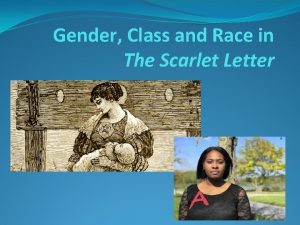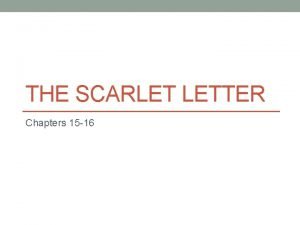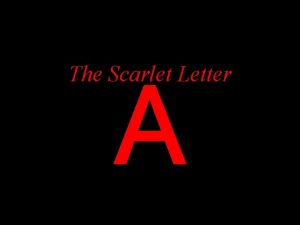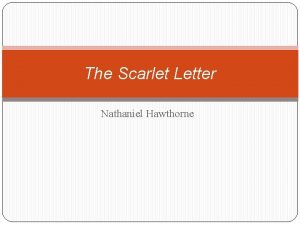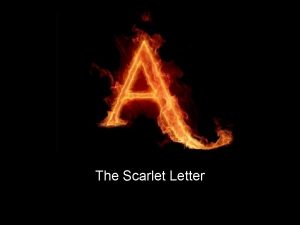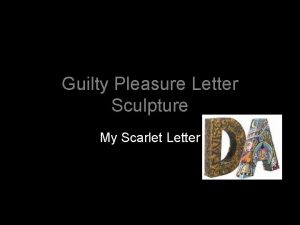Gender Class and Race in The Scarlet Letter






- Slides: 6

Gender, Class and Race in The Scarlet Letter

Hester Prynne, C’est moi At the beginning of «The Custom-House, » Hawthorne denounces his «autobiographical impulse, » which has led him to write the introductory sketch. The denunciation can be applied also to The Scarlet Letter as a whole, since, as many critics have stressed, Hawthorne clearly identifies with his heroine – an article about Hawthorne’s gender anxieties by Robert K. Martin is aptly titled «Hester Prynne, C’est moi. » In the romance, the complex intersections of the gender, race and class dimensions obliquely mirror Hawthorne’s ambiguous perception, interpretation and evaluation of these interconnecting issues inside mid-19 thcentury American society, and of his own positioning inside that web of contaminations and conflicts.

An author with no identity Hawthorne’s difficulty in finding a cultural identity in America can be signaled by his statement that he is following the example of the «famous ‘P. P. , Clerk of this Parish, ’» the never existed author of an 18 th-century mock autobiography. Besides, he comments that «the printed book, thrown at large on the wide world, » must «find out the divided segment of the writer’s own nature, and complete his circle of existence by bringing him into communion with it» – thus stressing again that his self is not «stable» and independent, but must rely on others (the readers) completing the communication cycle and thus acquiring the status of «author. » In the romance, Hester is at the beginning excluded by this «community of communication, » and is secluded into her own «magic circle» together with her child (and Pearl is often implicitly compared to a book which is difficult to be read, and without an «author» – a father).

A search for A-uthority «The Custom-House» is about how Hawthorne came to write The Scarlet Letter – or better, how the story of Hester Prynne finally turned Hawthorne into a major author (something of course Hawthorne did not know yet when he was writing the sketch…). Throughout the sketch Hawthorne is in search for his lost (or not yet attained) authority as a writer. He even comes to the point of summoning a ghost, that of his predecessor as custom surveyor, Jonathan Pue, in order to project on this figure of past authority his need to have a different forefather from those he has somewhat dismissed (mirroring his own dismissal by them) at the beginning of the sketch. Hawthorne’s choice of a different authority, based on writing and the power it has of giving a voice to those (like the women) who are not allowed to have it, is reflected in Hester’s refusal to acquiesce to the Puritan authority, and in her re-writing of the scarlet letter through the art of embroidery (just like Hawthorne «embroiders» the manuscript with his own art). One intersection (here between gender, class – Hester is a woman worker – and art) comments the other…

Distance from power Another feature that connects Hawthorne in «The Custom-House» to Hester in The Scarlet Letter is their distance from public power, even if they are at the very heart of it (Hawthorne as a public officer, Hester first as the living embodiment of what the Puritan community is not and then as its most appreciated «professional» worker). Hawthorne’s uneasiness with established power is first represented through the hostile symbol of the American Eagle, and at the end by the political plot that brings about his own demise, putting him on a «scaffold» where he will be «decapitated, » just like Hester is exposed to the public gaze on a scaffold.

A betrayer of his/her class, religion, gender, family (and race? ) Hawthorne represents both himself and Hester as betrayers of a number of power systems. As a «writer of story-books, » he is considered by his ancestors as «degenerate, » because he does not comply with the requirements of his class (he should have some «business in life» ), his religion (he does not «glorify» God), of his gender (he is implicitly not «manly» enough), of his family of course, and maybe even of his race, because he is depicted as a «fiddler, » like the street musicians who were usually of black or not exactly white (the Italians…) descent. Hester betrays her class because she works instead of leaning on his husband as breadgiver, her religion because she breaks the sacred bond of marriage, her gender because her behavior is not «womanly, » her family through her husband, and maybe her race, as it is implied by come comparison with the Indians (her cottage is on the margins of Boston, close to the forest, to the wilderness).
